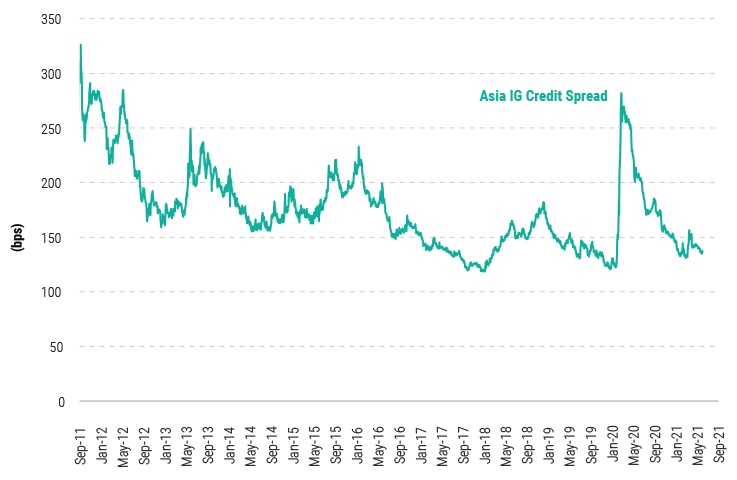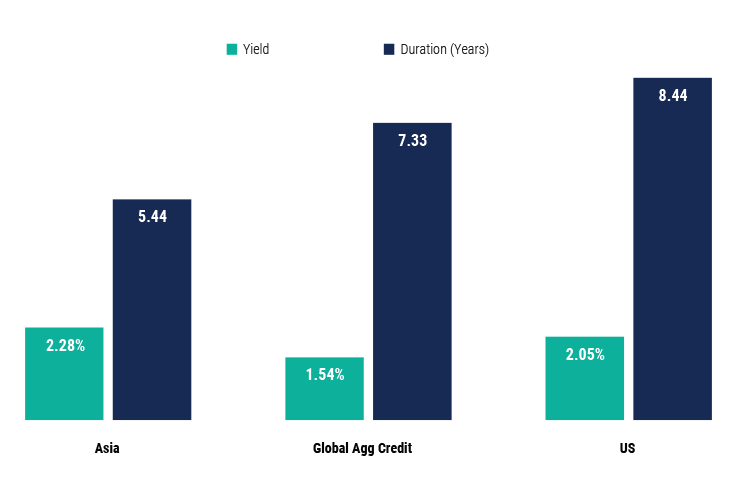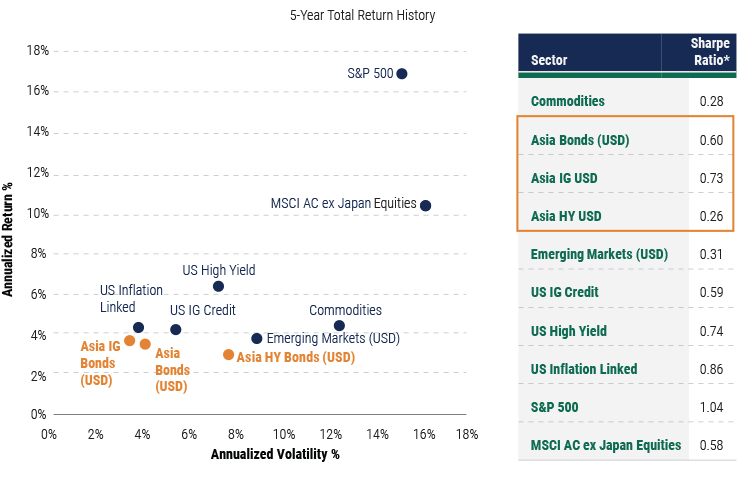High quality Asia bonds will likely continue to attract yield seekers amid uncertain markets. The hard currency investment grade (IG) segment, which makes up nearly 80% of the market, offers distinct advantages compared to developed market peers, making these bonds compelling diversifiers in global portfolios.1
Arthur Lau, Head of Asia ex Japan Fixed Income, and Omar Slim, Senior Portfolio Manager, Asia Fixed Income, answer questions about opportunities in Asia IG bonds and the sector’s prospects and potential risks.
Given recent bond market volatility, how do you expect Asia IG bonds to perform in the months to come?
Lau: We believe conditions remain ripe for Asia IG’s continued strong performance this year with the region’s economies poised to progressively open up. Asia IG bonds have been insulated from recent credit scares, and we are expecting a greater dispersion of returns within the IG space. One obvious example is the divergence between the Chinese real estate issuers and the rest of the Asian segments, which so far have been almost entirely spared from spread widening. We expect the epicenter of weakness from the Chinese real estate market to remain in the high yield segment, although some volatility may radiate to weaker Chinese real estate investment grade names.
Asia Credit Spreads Still Have Room for Compression

Slim: Broadly speaking, credit metrics in Asia, such as corporate net leverage have remained relatively low compared to US, Latin America, and other emerging markets, while interest coverage ranked highest relative to these three regions.2 That, along with a stable Asian institutional investor base should anchor credit spreads.
What benefits can Asia IG bonds offer a global portfolio?
Lau: Asia IG offers better yield than investment grade bonds in other regions, while duration is shorter,3 offering a buffer against rising interest rates. In terms of diversification, Asia IG offers a higher Sharpe ratio4 than US bonds, US inflation-linked, and global equities. It also offers exposure to China and the rising economies of South and Southeast Asia that still remain underrepresented in global bond indexes. A stable regional institutional investor base could potentially dampen volatility.
Asia IG Still Offers Higher Yield With Shorter Duration Than Peers

Asia IG Bonds Offer Better Risk-Adjusted Returns Than Other Major Asset Classes

How are you positioned in the Asia IG market?
Slim: Our positioning reflects our expectation of more return dispersion in the next few quarters. This is reflective of a few investment themes dominating the Asia credit market, the most important of which is an evolving Chinese policy environment. China is the largest component of the Asia credit market and is expected to continue to grow in market share. As such, Chinese developments have wide-ranging ramifications for the overall market. In 2021, Chinese policy makers clearly signaled that sovereign support will be, at the very least, less forthcoming and any policy support will be highly targeted. This is a theme that we think is not fully priced in yet. It drives our more cautious positioning within the Chinese space, consistent with our investment process that simultaneously analyzes fundamentals, valuations, and technical factors. Our positioning also integrates our environmental, social and governance (ESG) views, which are an essential part of our selection process.
What potential risks are on your radar?
Slim: There are three risks that we are focusing on. First, Chinese investing is undoubtedly going through a paradigm shift and policy risk is inherently higher during that phase. We have reasons to believe that policy makers will continue to be able to fine-tune policy without creating systemic risk. Therefore, our base case scenario is that volatility, when it occurs, tends to be localized in one segment of the market. Second, the pandemic continues to dominate headlines but there’s growing divergence in how Asian countries are approaching it. For instance, China and Hong Kong continue to pursue a “Zero Covid” policy while Singapore is trying to “live with the virus.” This has economic and investment repercussions. Third, regional and geopolitical risks are elevated; although for now, they continue to be a tail risk.
After the credit scares last year, particularly in the high yield segment, what is the outlook for default risk in 2022?
Lau: We expect the overall default rate in Asia to fall in 2022, primarily because of lower expected defaults in the Chinese property sector. Nonetheless, we think selective sovereign and Chinese property developers that face continued financing and liquidity pressure may have to restructure or default in 2022. As such, default risk in select sectors may remain high, albeit in an improving trend.
Meanwhile, a benign economic outlook should continue to provide a constructive backdrop for corporates. Among IG corporates, the credit matrix in general continues to improve. We currently expect less than 1% fallen angel risk in the Asia IG investible universe under our coverage.
How do you navigate across Asia’s trillion-dollar bond market? What should investors bear in mind?
Lau: There is no substitute for thorough credit research and credit selection. Our investment thesis favors greater issuer differentiation to find value opportunities in Asia bonds. At the core of PineBridge’s global fixed income organization is a team of credit analysts who are highly experienced in different sectors and markets. This deep sector knowledge is combined with on-the-ground insights to help us create a complete credit picture of the potential returns as well as risks. Having the agility to reposition our portfolio according to market conditions is also important, and may be harder to achieve through index tracking. Over the long run, the ability to navigate Asia’s changing economic, regulatory, and geopolitical landscape will also play a key role in investing successfully in this asset class.
Footnotes
1 JPMorgan, 30 September 2021.
2 BAML, PineBridge Investments as of 30 June 2021.
3 Duration measures how much bond prices are likely to change when interest rates change. It is a gauge of interest rate risk and is expressed in years. The shorter the duration, the less sensitive a bond’s price is to interest rate changes.
4 Sharpe ratio is the most common measure for calculating risk-adjusted return for a fund. The Sharpe ratio is the average return earned in excess of the risk-free rate per unit of risk (volatility). The higher the Sharpe ratio, the better the returns compared to the risk taken.

